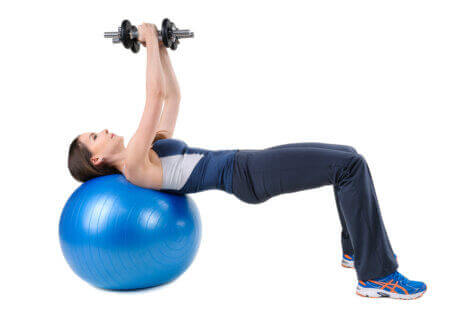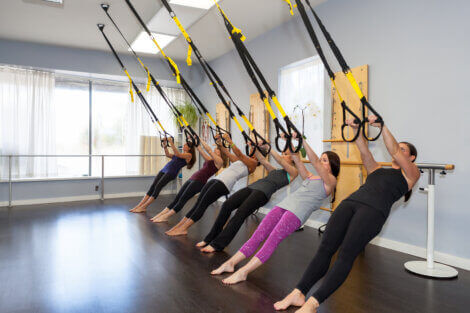Unilateral Exercises to Strengthen Your Core

Typically, when someone wants to work their core, they tend to stick to classic exercises such as planks, push-ups or crunches with weights. However, if you’re really striving for that stronger, toned core, you can take it a step further by including unilateral exercises in your workout. You’ll find three exercises below.
The body can tend to become unevenly balanced due to the unique resistance in one-sided exercises. To counteract this imbalance, you’ll need to work on strengthening your core further. This will correct any imbalances in posture.
When you focus on strengthening your core, your body becomes more balanced, according to a study published by the European Journal of Applied Physiology. Now, what exercises can help you to strengthen your core?
Unilateral exercises to strengthen your core
Below, we’ll show you some unilateral exercises that’ll help you to strengthen your entire core. Don’t hesitate to put them into practice!
Dynamic unilateral lunges
- Initial position: standing, holding a weight in one hand.
- Eccentric phase: take a long step forward, enough so that your hip and knee are at right angles. Lower your back knee until it’s almost touching the ground. It’s important to pay attention to your posture. Your core should be straight and your knees in line. The front knee shouldn’t be past your toes. Hold the position for 5-10 seconds.
- Concentric phase: return to the initial position. For those who aren’t that familiar with lunges, it’s recommended that you stand up straight and pause for a moment before the next movement. However, for those who are used to lunges, you can increase the intensity by continuous movement.

Unilateral chest opener using a fitball
- Initial position: to start, lay on a fitball with your upper back and head resting on it. Your feet should be on the ground with your knees at right angles, and the rest of your body in a straight line, from your head to your knees.
Since this is a unilateral exercise you should just use one weight. Hold your arms directly above you in line with your shoulders with the weight in one hand before starting the movement.
You should bend your elbows slightly, with your free hand next to the one with the weight. Make sure your body stays aligned, since the objective is to maintain your balance on the fitball.

Variation of the chest opener using a fitball. For a unilateral exercise, just use one weight.
- Eccentric phase: maintaining the initial position, you should gradually separate your arms, bringing them outwards. Make sure you don’t lock your elbow at any time. The further you move your arm away from the center, the greater the weight on that side will be and you’ll need to keep your core activated to counteract this. Once your wrists are at shoulder level, that’s time to start the concentric movement.
- Concentric phase: bring your arms slowly back up to center. Keep your core stable at all times to avoid imbalance.
TRX unilateral row
Before starting, you should be aware that it’s essential to keep your core activated so that your body doesn’t become misaligned at any point. Both your shoulders and your hips should be straight throughout the exercise.
You should also make sure your hips don’t turn during the exercise. Avoid rotation by keeping your core firm.

Example of a TRX row using both arms.
- Initial position: to start, take one TRX strap with one hand and stand not quite vertically, leaning backwards a little with your arm stretched out straight. The more horizontal your body, the greater the resistance of the exercise will be.
- Concentric phase: using just the one band, bend your elbow, pulling your body weight up with that arm. Your elbow should come down, not out, and be almost touching your side at the end of this phase.
- Eccentric phase: return to the initial position, controlling your movements so that you don’t just fall back with a jerk. Keep your hips and shoulders aligned, resisting the rotational pull of your body’s weight.
Add other unilateral exercises to your routine
Before finishing up, we want to remind you that since these are unilateral exercises, you should never forget to work both sides of your body evenly. Also, despite the fact that these exercises are focused on a thorough core workout, they’ll also work various other muscle groups simultaneously.
These are just a few examples of unilateral exercises. However, there are many more. So, if you want to improve your core workout, don’t hesitate to ask your trainer for other exercises. Anything you do to strengthen your core will be worth it!
Typically, when someone wants to work their core, they tend to stick to classic exercises such as planks, push-ups or crunches with weights. However, if you’re really striving for that stronger, toned core, you can take it a step further by including unilateral exercises in your workout. You’ll find three exercises below.
The body can tend to become unevenly balanced due to the unique resistance in one-sided exercises. To counteract this imbalance, you’ll need to work on strengthening your core further. This will correct any imbalances in posture.
When you focus on strengthening your core, your body becomes more balanced, according to a study published by the European Journal of Applied Physiology. Now, what exercises can help you to strengthen your core?
Unilateral exercises to strengthen your core
Below, we’ll show you some unilateral exercises that’ll help you to strengthen your entire core. Don’t hesitate to put them into practice!
Dynamic unilateral lunges
- Initial position: standing, holding a weight in one hand.
- Eccentric phase: take a long step forward, enough so that your hip and knee are at right angles. Lower your back knee until it’s almost touching the ground. It’s important to pay attention to your posture. Your core should be straight and your knees in line. The front knee shouldn’t be past your toes. Hold the position for 5-10 seconds.
- Concentric phase: return to the initial position. For those who aren’t that familiar with lunges, it’s recommended that you stand up straight and pause for a moment before the next movement. However, for those who are used to lunges, you can increase the intensity by continuous movement.

Unilateral chest opener using a fitball
- Initial position: to start, lay on a fitball with your upper back and head resting on it. Your feet should be on the ground with your knees at right angles, and the rest of your body in a straight line, from your head to your knees.
Since this is a unilateral exercise you should just use one weight. Hold your arms directly above you in line with your shoulders with the weight in one hand before starting the movement.
You should bend your elbows slightly, with your free hand next to the one with the weight. Make sure your body stays aligned, since the objective is to maintain your balance on the fitball.

Variation of the chest opener using a fitball. For a unilateral exercise, just use one weight.
- Eccentric phase: maintaining the initial position, you should gradually separate your arms, bringing them outwards. Make sure you don’t lock your elbow at any time. The further you move your arm away from the center, the greater the weight on that side will be and you’ll need to keep your core activated to counteract this. Once your wrists are at shoulder level, that’s time to start the concentric movement.
- Concentric phase: bring your arms slowly back up to center. Keep your core stable at all times to avoid imbalance.
TRX unilateral row
Before starting, you should be aware that it’s essential to keep your core activated so that your body doesn’t become misaligned at any point. Both your shoulders and your hips should be straight throughout the exercise.
You should also make sure your hips don’t turn during the exercise. Avoid rotation by keeping your core firm.

Example of a TRX row using both arms.
- Initial position: to start, take one TRX strap with one hand and stand not quite vertically, leaning backwards a little with your arm stretched out straight. The more horizontal your body, the greater the resistance of the exercise will be.
- Concentric phase: using just the one band, bend your elbow, pulling your body weight up with that arm. Your elbow should come down, not out, and be almost touching your side at the end of this phase.
- Eccentric phase: return to the initial position, controlling your movements so that you don’t just fall back with a jerk. Keep your hips and shoulders aligned, resisting the rotational pull of your body’s weight.
Add other unilateral exercises to your routine
Before finishing up, we want to remind you that since these are unilateral exercises, you should never forget to work both sides of your body evenly. Also, despite the fact that these exercises are focused on a thorough core workout, they’ll also work various other muscle groups simultaneously.
These are just a few examples of unilateral exercises. However, there are many more. So, if you want to improve your core workout, don’t hesitate to ask your trainer for other exercises. Anything you do to strengthen your core will be worth it!
All cited sources were thoroughly reviewed by our team to ensure their quality, reliability, currency, and validity. The bibliography of this article was considered reliable and of academic or scientific accuracy.
- Behm, D. G., Leonard, A. M., Young, W. B., Bonsey, W. A. C., & MacKinnon, S. N. (2005). Trunk muscle electromyographic activity with unstable and unilateral exercises. J Strength Cond Res, 19(1), 193-201.
- Saeterbakken, A. H., & Fimland, M. S. (2012). Muscle activity of the core during bilateral, unilateral, seated and standing resistance exercise. European journal of applied physiology, 112(5), 1671-1678.
This text is provided for informational purposes only and does not replace consultation with a professional. If in doubt, consult your specialist.








